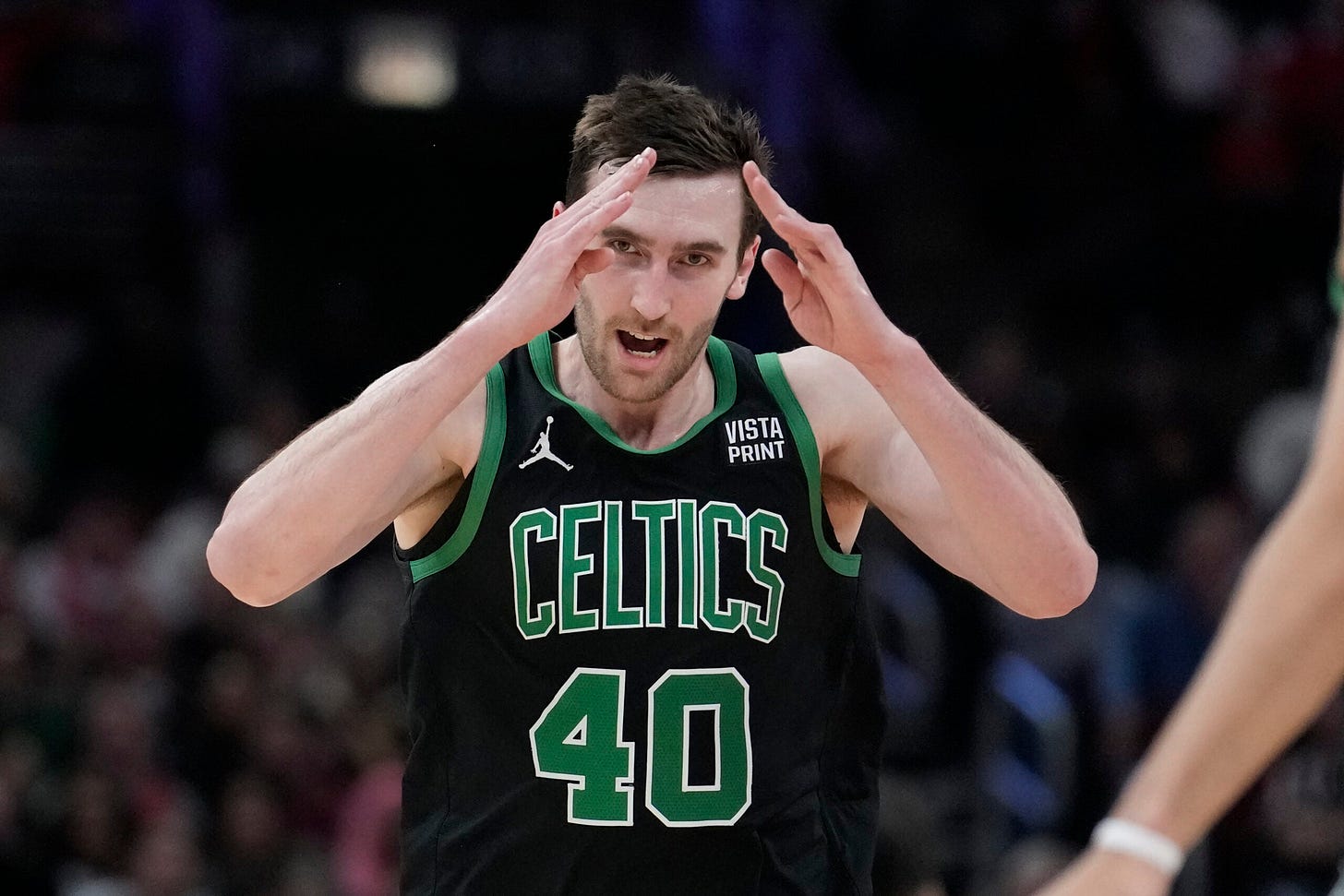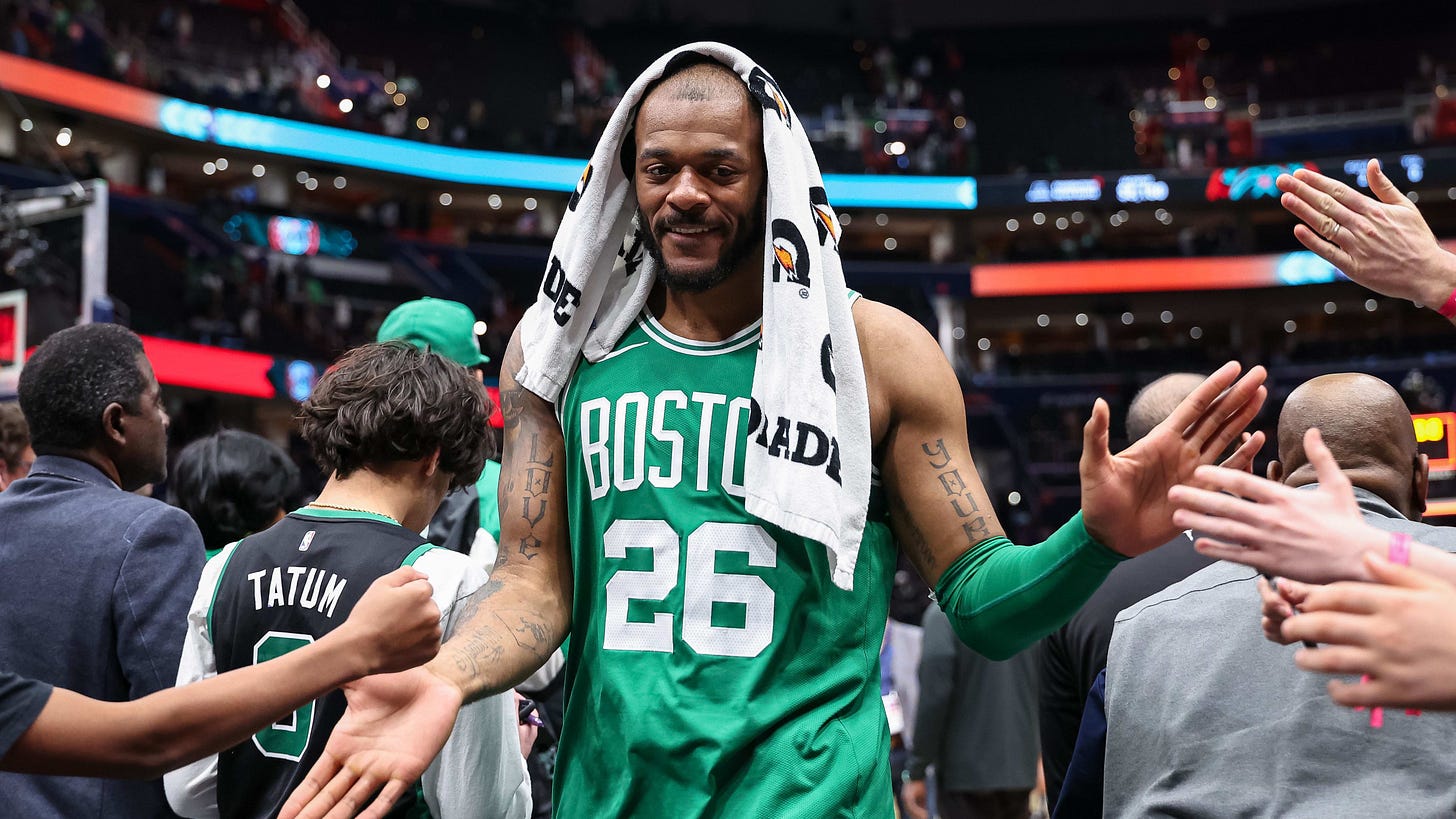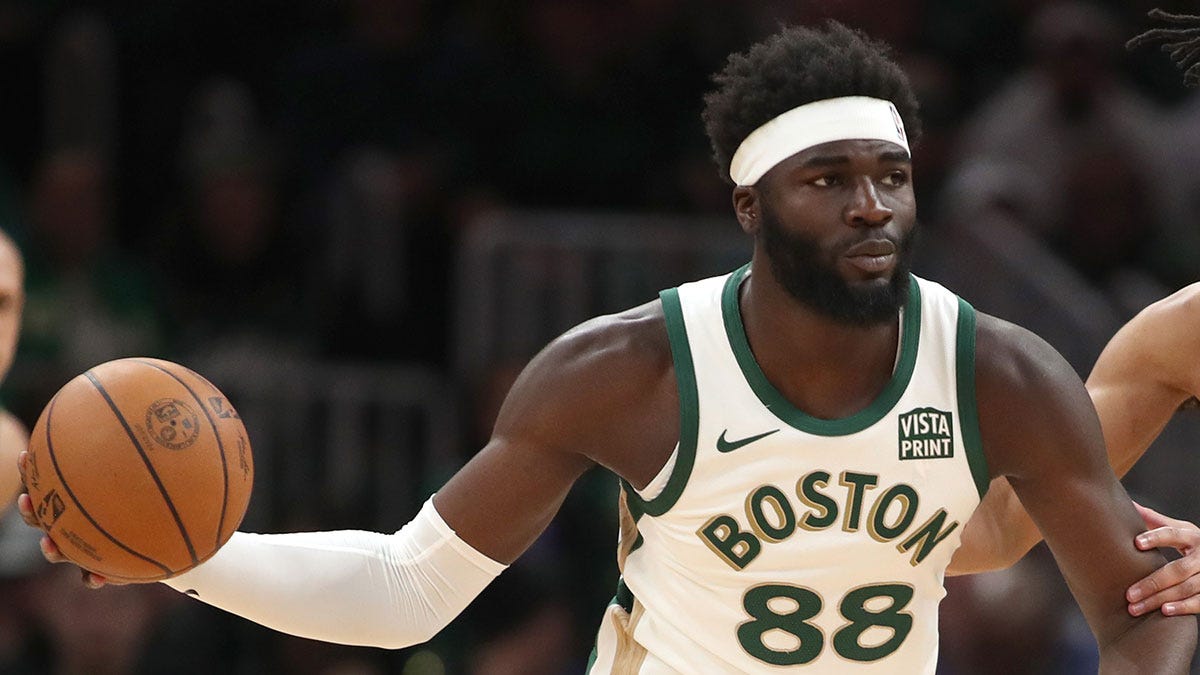Coping without KP
Porzingis has been ruled out for at least a 'couple of games.'
Kristaps Porzingis is out for at least a ‘couple of games.’ When facing the Miami Heat on Monday, he suffered a soleus strain after pulling up from a non-contact injury.
So, the Celtics are forced to push ahead without their ‘most important player.’ Hey, those are Jayson Tatum’s words, not mine.
They will likely close out this series against the Heat without him and potentially head into the second round without him, too. Overall, losing Porzingis for a couple of games is a best-case scenario. Things could have been a lot worse. At least this way, he’s back before the Conference Finals — we hope — and ready to make an impact in the NBA Finals if/when the Celtics get there.
Still, Joe Mazzulla’s team must find a way to maintain their elite-level offensive and defensive production between now and then. Fortunately, we’ve got an ample sample size of games with Porzingis out of the rotation. He sat the opening nights of back-to-backs throughout the season. Horford did well in those games, proving he can still be a starting big when needed.
This season, the Celtics have played 4,152 possessions without Porzingis on the floor. Mazzulla’s most common lineup without Porzinigs consists of Jrue Holiday, Derrick White, Jaylen Brown, Jayson Tatum and Al Horford. That unit has played 649 possessions together; they’re a +1.3 per 100. They’re 21-4 without Porzingis this season.
Mazzulla will likely stick with that rotation tonight to begin the game and lean on it moving forward. In terms of offense, not much will change. Horford is shooting 42% from the perimeter this season. He’s drained 108 of his 257 shots. He can stretch the floor by working in the corners. He can screen. He can slip, pop, roll and veer.
This is the same Horford that was the starting big man en route to the 2022 NBA Finals. The same guy that has been part of multiple Conference Finals runs with this core. We know what we’re getting; what we’re getting is more than good enough to navigate in the next few weeks.
I’m not worried about Porzingis being out of the rotation right now. I will be worried if the timeline for his recovery starts getting pushed further back. I’ll also be worried if he aggravates the issue when he’s back on the court.
Rather than worrying about things outside of Mazzulla’s control, my focus has shifted toward how the Celtics can replace the versatile production Porzingis brings to the rotation. How do you replace a Unicorn? The short answer is that you don’t. The longer answer is a bit more nuanced.
Do you remember a few years back, before Tatum took his leap as a rebounder and Enes Kanter patrolled the paint, giving up blow-by drives? The consensus was that Boston had to rebound by committee. They didn’t have a certified glass cleaner. Yet they knew they needed to secure defensive boards to compete at a high level. It’s a prerequisite, after all.
That’s kind of my thought process in terms of filling out Porzingis minutes and roles. You don’t have anyone else on the roster who can do everything he can do all by themselves. You do have four bigs that can each give you some of what he can, though.
What I mean by this is, say, Terry Rozier miraculously gets thrust into Miami’s rotation. He’s cooking the defense off the dribble and getting to the rim at will. Horford’s lack of height isn’t working as a shot deterrent. Well, now you start to look toward Luke Kornet or Neemias Queta. Both are 7-footers who provide resistance around the rim simply by being in the paint.
It’s about plugging holes as they appear and trusting the guys further down your bench to stick to the game plan and give the team what’s needed. Let’s take a look at what each big brings to the rotation in terms of how they can fill some of what Porzingis brings to the table.
Al Horford
Horford will allow Mazzulla’s team to keep running their five-out offense. He’s a capable perimeter shooter, a willing screener, and can give you some passing out of the short-roll or when working in high post actions such as elbow sets or horns.
He’s versatile enough to attack off the dribble. He’s smart enough to pass out of mismatches. And he’s strong enough to get some work done on the low block if he finds himself with favorable coverage.
On the defensive end, Horford can work as a drop defender or as part of a switching system. I prefer seeing Boston play a pressure-based defense when Horford is on the floor. With his lack of height and explosiveness, he’s best when cutting off angles or forcing players to their weaker hands. You can still do those things as a drop defender, but sometimes the ball-handler already has some momentum or will look to shoot a floater over the top.
Regardless of how Horford is utilized while Porzignis is out, we know there’s a reliable deputy who is ridiculously experienced and knows how to play with his teammates. Horford coming off the bench this season has been a luxury, now his presence is a necessity.
Luke Kornet
A few weeks back, I wrote about Zach Edey and why Luke Kornet would be the ideal type of mentor for the incoming rookie. Both bigs are non-shooters in a perimeter-shooting world. Kornet has developed his game and found a way to be impactful in a five-out system while not possessing the slightest crumb of scoring gravity outside of the paint.
Kornet’s value on offense is as a screener. His timing has taken insane jumps. He knows when to let the contact occur. He knows when to slip. He knows when to pop. And he can also ghost screens before flowing into pin-downs. Kornet uses his movement to survive on the perimeter, and Boston rewards him by running some secondary playmaking through him via short-roll decision-making or as a hand-off hub.
Defensively, Kornet is a reliable drop defender who excels in containing the ball-handler as they come off screens and has the size to be a legitimate rim deterrent and rim protector. He doesn't have the lateral quickness to be part of a switching system, but given his size and length, he is still a reliable backup that can positively impact a defense if put in positions to succeed and has willing and intelligent help defenders around him.
Xavier Tillman
We haven’t seen much of what Tillman brings since he joined the Celtics from the Memphis Grizzlies around the trade deadline. He’s been limited to small cameos and the occasional run off the bench. His game projects to be similar to Horford. Tillman could potentially be a better passer, but we haven’t seen enough within Mazzulla’s system to know that for certain.
What we do know is that Tillman is rapidly working on improving his perimeter jumper. He’s a decent screener but lacks the timing of Kornet and the processing speed of Horford. Everything has looked a little clunky with Tillman, but how much of that is down to being in a new system with new teammates vs. not being a great fit, we won’t know — at least not this season.
Tillman does bring a physicality that the Celtics were lacking at the five. He’s a sturdy body that has shown solid upside in the post or when sealing off defenders for cutters or drives. He’s also capable of using that physicality on the defensive end.
If Tillman does see some rotation minutes in Porzingis’ absence, I would expect the Celtics to play a switch defense rather than a drop. He’s mobile enough and strong enough to help push a pressure defensive system and it suits his body type more due to a lack of size.
If Tillman is included in the rotation, it’s likely because Mazzulla wants more physicality and mobility in the frontcourt. I would expect to see him get the nod ahead of Kornet in matchups where the opposing bigs are winning the physicality battle or are finding ways of bullying their way to the rim. Tillman also offers somewhat of a like-for-like replacement, which could provide some systematic continuity between the starting unit and bench, assuming the Celtics’ gameplan was working and the coaching staff was reluctant to move away from it.
Neemias Queta
Queta does bring something different to the Celtics rotation. He is their lone rim-running big. He has a high motor, great size and great physicality. We’ve seen him change the tempo of a game when he’s part of the rotation, and his presence in the dunker spot offers some vertical spacing. Queta is also the most explosive big on Mazzulla’s roster this season.
To begin the season, screening was somewhat of a weak point for Queta. He was willing to set them, but they were often a step below the action and failed to generate the separation and contract required. As the season has worn on, he’s improved in that area and can be relied upon to help spring his teammates free.
On defense, Queta is exclusively a drop coverage option. He’s still incredibly raw, so asking him to do anything more than contain the roller, protect the rim and close out on shooters is likely setting him up to fail. It’s not that he isn’t capable; it’s that he’s not ready.
I would be interested to see where and more importantly why Mazzulla would go to Queta. He’s buried deep on the bench and is likely too raw to be a major force in the playoffs. However, with his size, rim-running and physicality, there may be spots for him to see the floor while Prozingis is out with injury. I’m just not sure where those spots would be or how he would cope with the play style of the postseason. After all, he’s already a walking foul magnate; what happens when he’s injected into a chippy game?
My guess is simple
Horford starts, and Kornet comes off the bench. If Kornet is struggling with the physicality, or if the Heat are finding ways to attack his drop defense, Tillman steps in to help provide some pressure defense on the perimeter and adjust the pick-up points.
Queta is literally a break-glass prospect that could go either way. He could check in and dominate for 10 minutes. Or he could be targeted on every action and be played back off the floor. You don’t know which way it’s going to go, and in a game that could potentially close out the series like tonight’s, that’s not a risk you take unless you’re chasing the game and need a high-risk high-reward dice roll.
Episode 2 of the podcast is out
Brenden Nunes of Sactown Sports joined me for this one. Brenden and I have covered the Celtics on podcasts on multiple occasions. He was my first co-host on the CelticsPod for CelticsBlog, and was my first-ever co-host when we began chasing this career in covering basketball. We hit on a few different topics.
Derrick White’s career night
Porzingis’ injury
Pritchard’s inconsistent play this season
Holiday’s role as a connector and why White is thriving in a similar role
Boston’s path to the NBA Finals
Why the depth of the West could work in the Celtics’ favor
And some other stuff
If you prefer to watch these discussions rather than just listen, the first video of the Celtics Chronicle YouTube channel is up. Please subscribe there, it’s free, and it will help me work toward monetizing that page.
Show some love!
Sharing is caring! If you liked today’s post, sharing it on social media is the best way of supporting my work. It helps new people find the newsletter and helps the community grow. It also means more coming from the readers than it does coming from myself.
If you’re new here, hit the subscribe button to stick around. If you’ve been here for a minute, I appreciate you.
Hey! You! The playoffs are in full swing! Sign up to the Celtics Chronicle newsletter to get Celtics coverage straight to your inbox! And if you’re already signed up, why not go paid to unlock every post, week in and week out!
Finally, this was a different type of article to what I usually do — I like to mix things up…Do you want more of these opinion pieces? Vote below to let me know.
Catch you all tomorrow!





